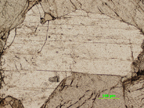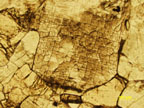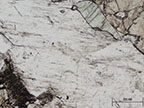|
Wollastonite
|
|
Property
|
Value
|
Comments
|
| Formula |
CaSiO3 |
Pyroxenoid group. Usually pure, but Mn and Fe2+ can substitute for Ca. |
| Crystal System |
Triclinic |
|
| Crystal Habit |
Columnar and fibrous elongate grains, often with twinning |
|
| Cleavage |
Perfect cleavage on {100}, good cleavages on {001} and {-102} |
Splitery cleavage fragments. Angles of cleavage: 84.5 degrees, and 70 degrees. |
| Color/Pleochroism |
Colorless, white, greyish, often with yellowish or brownish tint. Vitreous. No pleochroism |
|
| Optic Sign |
Biaxial (-) |
|
| 2Valpha |
36-60 degrees |
Most wollastonite has a 2V of ~40º. This can be higher for Fe-bearing samples.
|
| Optic Orientation |
X^c = -30 to -44 degrees
Y^b ~ 0 degrees
z^a = +35 to +49 degrees
O.A.P. ~ (010) |
Cleavage fragments are length slow or length fast depending on orientation due to Y being parallel to fiber length. |
Refractive Indices
|
alpha: 1.616-1.645
beta: 1.628-1.652
gamma: 1.631-1.656
delta: 0.013-0.017
|
Increase with Fe and Mn content. |
| Max Birefringence |
0.013-0.017 |
Wollastonite resembles tremolite and pectolite, but both have a higher birefringence. |
| Elongation |
Grains elongate parallel to b |
|
| Extinction |
Parallel |
Elongate crystals display parallel extinction. |
| Dispersion |
r > v |
|
| Distinguishing Features |
Colorless to grey in thin sectionwith moderate to moderatly high relief. First order interference color yellow-orange. One perfect cleavage and two good cleavages producing splintery cleavage fragments. H = 4.5-5. G = 2.86-3.09. Streak
is colorless or white. |
| Occurrence |
Occurs commonly as a product of contact and/or regional metamorphism in limestone and dolomite. Associated minerals include calcite, and grossular in hornfels, tremolite, epidote group members, diopside, and other Ca-Mg silicates. |
| Sources |
Deer, W.A., Howie, R.A., Zussman, J. (1963) Rock-Forming Minerals, Chain Silicates, p. 94-100. Longmans, Green and Co LTD, London. |
| Editors |
Sarah Martell (AC '06) , Carolyn Tewksbury ('07), Jessica Chang ('17) |


